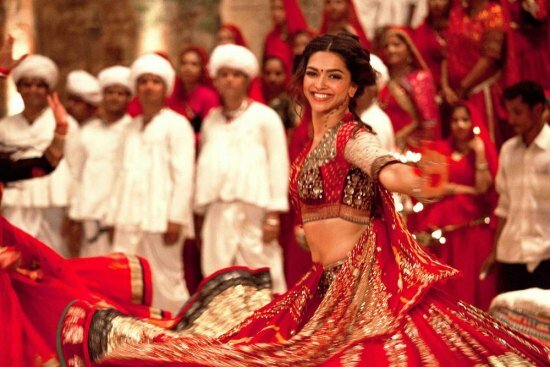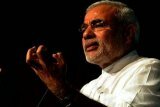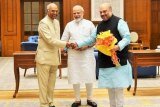Film Review: Goliyon ki Rasleela Ram Leela

To paraphrase, he makes Mahesh Bhatt’s self-indulgence seem understated.
In interviews he reminds you of his childhood spent in a Bhuleshwar chawl where you had to shout to be heard. Hence the cacophony of Hum Dil De Chuke Sanam’s extended family. He tells you about his mother’s thwarted dreams as a dancer, and his love for her that prompted him to add her name to his. And of the alcoholic father with whom he’s been trying to make his peace through all his films––HDDCS’s Sameer even looks heavenward and throws punches at him. An article published in a respectable business paper after the release of Guzaarish (2010) likened him to the tragic genius of Guru Dutt and we shan’t react to that.
Still, Bhansali is obviously obsessed with wounded people. He wants them to be heroic, but won’t allow them to breathe without breaking into hysterics. Nor us. I’ve often felt trapped in his films. Like what if this frenzied fuss never ends and I have to spend the rest of my life in another man’s tortured fantasy?

Fortunately, in Ram Leela some of the characters escape his stranglehold from time to time. Particularly Leela (Deepika Padukone), who delivers a couple of solid punches in key dramatic moments. He has a flair for directing women. Manisha Koirala, Aishwarya Rai, Rani Mukherji have all given him their best. So does Padukone, as the feisty girl who refuses to let her gleefully menacing mother (Supriya Pathak demonstrating how over-the-top can be done just right) crush her.
Leela knows her mind and speaks it, but the tone of the narrative being overtly patriarchal her life never really is hers to choose. Still she breaches the precincts, and not just of her haveli, making a particularly favourable impression in her romantic scenes with Ram (Ranveer Singh). Till he imposes his manhood (and oh, let’s not talk of his chiselled body and perilously low-hanging dhotis, not to mention the ganji endorsement that even Bhansali’s self-styled genius couldn’t resist) by screaming her into a corner at a turning point in the narrative before stomping off to ruin the love story.
The machismo is disturbing. From the opening scene where Leela’s cousin Bhavani (Gulshan Devaiah) chases Ram’s little nephew across rooftops trying to shoot him down, to a couple of horrific slow motion sequences of women being brutalised by gun-totting goons in the second half.
More like this
In the run-up to the film’s release, Bhansali spoke of his admiration for Ketan Mehta’s Mirch Masala (1986). Unlike that film where the metaphor of the red chillies was crucial to the theme of women's resistance against male oppression, here the chillies and the cholis are all part of the prettiness and nothing more. So is the allusion to V Shantaram and Dada Kondke.
Although objectively speaking, he's right. What's Ram Leela if not an amalgam of Shantaram and Kondke channelled through Shakespeare's Romeo and Juliet at the designer village nautanki?!
Deepa Deosthalee is a film critic and a regular contributor to Cinemascope column. The views and opinions expressed in this article are those of the author and does not reflect the views of IndiaNewsBulletin.com. More of Deepa's work can be found on her site Film Impressions.
Most read
- 2017: Full list of Indian States, capitals and their Chief Ministers; Nitish Kumar quits and takes oath again as Bihar CM!
- List of all the major rivers of India: Names, Origin and Length
- Ram Nath Kovind is 14th Indian President after Pranab Mukherjee. Here's a list of all Indian Presidents since 1950
- Indian cabinet September 2017: Full list of Ministers and their portfolios in Narendra Modi government
- Dosa recipe: How to make crispy Paper Dosa and Masala Dosa
- SIIMA 2016 Pics: South Indian Cinema stars dazzle in Singapore for the awards red carpet
- Navrangi Navratri 2016: UK Indians revel in the traditional magic of garba and dandiya in London
- Review: Shree Krishna Vada Pav Hounslow, Harrow
- South Indian actress Trisha Krishnan’s father passes away
- Recipe: Misal Pav – how to make missal masala, usal and tarri
India News Bulletin by email
More Lead Stories
- Pics: Salman Khan in London for his Global Diversity Award
- Osterley Gymkhana London hosts 70th Indian Independence Day Celebrations
- Indian tourists involved in fatal collision on M1 motorway involving minibus and 2 lorries
- 2017: Full list of Indian States, capitals and their Chief Ministers; Nitish Kumar quits and takes oath again as Bihar CM!
- Indian train meals not protected from rats, cockroaches, dust, insects, warn auditors












